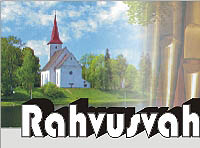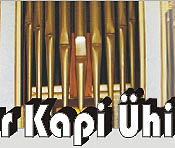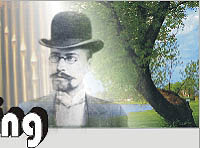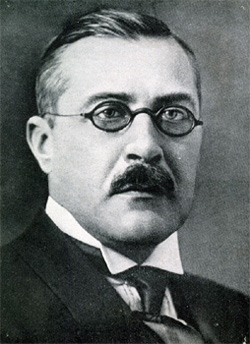| Kapp at the
Conservatory in Tallinn resulted from classical and religious traditions.
So formed Artur Kapp to famous person who had great influence on development
of Estonian music culture in the beginning of this century.
Artur Kapp was born on the 28 of February 1878 in Suure-Jaani
in the family of sexton. He had many brothers and sisters. His father
Joosep Kapp (1833-1894) got musical education in Zimse’s seminar
in Valga, attention to musical education of young Artur. Working in Suure-Jaani
as a sexton Joosep Kapp was well-known with his national enlightening
activity. In fact of the musical atmosphere at home, the child was early
interested in music and when he was 7 years old, he began his studying
under fathers supervise. Besides playing piano his father teaches him
playing organ, that was later his favourite instrument. As young boy he
often stayed in church with father and sometimes replaced him by religious
rites. He was rapt from music evenings of song company “Ilmatar”
in Suure-Jaani, founded from his father. In these evenings he also took
part the mixed choir “Ilmatar”. Once in that concert was performed
“Halleluuja” from Händel’s oratorio “Messias”
and young Artur played the organ parting. In that time he was 11 years
old and already performed as a soloist. Very important event in his life
was organ concert introduced by Miina Härma in Suure-Jaani church
in August 1891. If Miina Härma heard Artur’s playing, she suggested
the father to send his boy to the Conservatory of Peterburg. In this year
they started his studies in Peterburg and lived at Artur’s uncle’s
place (Feliks Martens). The boy couldn’t speak in Russian, but learned
quickly and had good advances. By entrance examination to the Conservatory
of Peterburg he had to play one choral prelude from J.S.Bach and five-voice
“Fantaasia” c-moll (Fantasy c-moll). If Louis Homilius asked
him to improvise something, the father doubted if Artur could. When Artur
had finished, professor Homilius said to the father: ”Dear colleague
you don’t know what your son can.”
Studies at the Conservatory of Peterburg were successful, he also hadn’t
any economical problems and he also lived at his relative place in Peterburg.
Artur Kapp was a talented student and soon he got the grant. At first
he studied in the organ class of L.Homilius, but later he also studied
in the piano class of professor Tiron. Last school year he studied piano
by Professor F. Cerny, who paid attention on classical music. Music theory
he studied by Professor A. Ljadov and harmony and counterpoint by Professor
Bernhardt. Here he first familiarised with Rudolf Tobias, who was 5 years
older than him. Tobias started his studying there 1893 and majored in
composition and organ. Artur Kapp followed Tobias´ suit and began
with composing; in 1896 was completed his first grandiose work - “Orelisonaat
f-moll” (Sonata f-minor key). Although it isn’t enough personality
in the music, it distinguishes because of his wonderful technical accomplishment.
In 1897 before the last course Artur Kapp performed this music on the
exam, on consequence of that N. Rimski-Korsakov propositioned Artur Kapp
to study by himself special composition. In 1898 Artur Kapp finished his
organ studying at the conservatory and gave many concerts in Peterburg,
Moskva and Tartu. He started his studying in composition class in the
same year when Tobias finished. In spite of that they often met because
Tobias worked as choir leader and organist by congregation of Jaani in
Peterburg. Loving music, especially organ music connected them and they
both were very talented improvisers. Many music and creative problems
were discussed together. With his music erudition and artistic believes
had Tobias great influence on Artur Kapp. Exactly at the same time Artur
Kapp wrote “I Viiulisonaat” (The first Violin sonata), some
solo songs and his first symphonic composition – overture “Don
Carlos”. This overture got ready in 1899 as an exam work and received
later attention not only in Kapp’s creation, but also in all Estonian
music. Together with Tobias` overture “Julius Caesar” belong
they to golden fund of Estonian music because of outstanding technical
realization and bright musical material.
As final work of conservatory Artur Kapp wrote in 1901 cantata “Paradiis
ja Peri” (Paradise and Peri), but unfortunately it has got lost.
After graduation he often performed in different cities of Russia and
gave many concerts, became there famous as a wonderful organist and improviser.
In 1903 the headmaster of conservatory in Moscow and the chairman of Music
Company of Russia V. Safonov propounded to Artur Kapp to begin working
as a principal of Music School in Astrakhan and in 1904 he started. Driving
with steam-ship on river Volga at the same year he familiarized and in
autumn 1904 married to German Marie Lichtenwald. Artur Kapp`s mother also
was a German. In the family there were three children: son Konstantin
(1906), Eugen (1908) and daughter Elisabet. In Astrakhan Artur Kapp had
besides practical activity in music school to conduct symphonic music
and he also organized regular concerts. He often performed in Astrakhan
and in other cities. He hadn’t enough time for composition. Still
he wrote in 1905 one of his authoritative compositions “Viimne piht”
(The Last Confess) for organ and violin, very attractive because of religious
feelings. Later Artur Kapp used this music in his oratorio “Hiiob”.
Living in Astrakhan Artur Kapp didn´t rupture connections with homeland,
he visited it repetitively. So he conducted the symphonic concert during
the music days of Tartu in 1909. Next summer he was invited to contact
symphonic concerts, devoted to the VII song festival of Tallinn.
One of the best works of those years was cantata “Päikesele”
(To Sun); it was realized in 1913 to the inauguration festivities of theatre
“Estonia”.
After seize power of communists his life became very complicated in Astrakhan.
Because of red terror and executions in masses Kapp lost many friends
and acquaintances. It was hunger and chaos everywhere. Besides the family
disagreements deepened - the wife with elder son Konstantin left, but
younger son Eugen and daughter Elisabet stayed with father. In these circumstances
Kapp had to do some reorganizations in his music school.
Artur Kapp reminded circumstances: ”The transition of music school
to commissariat of communistic education took place. I was left a chairman
of music school and nominated emissary. It was organized by “Rabis”-
“Rabotniki Isskustva” (Workers of art). To the organization
belonged actors, musicians, dancers, employees of theatre, even acrobats
and clowns. The leading of music department was “trusted”
to me I have to conduct symphonic concerts and organize evening of chamber
music. I have to explain to people content of performed music work. Also
I have to conduct orchestra on the meeting. Each person got a half pound
of sausages as a fee. Money became unvaluable; nothing was to buy; from
Co-operative society we got something on the basis of card. To not spend
the last pair of boots, I walked in shoes made of bass. My little 8-years
old daughter was housewife at home. Our bred ration was daily three- quarter
of pound for daughter and one pound for me as for leading person.
At the time of Bolsheviks (2,5 years) I lost weight 2,5 KGs. They thought
me a real red because I organized concerts in church.
Some people even asked me to bring dancers into the church. I evaded:
will we later see! Big crowd visited the church, they looked for peace
of mind after the attack of communists. The citizens of Astrakhan have
to stand a lot of. The sad life around influenced me to write symphonic
poem “Hauad” (The Graves). At that time got ready his “Keelpillide
kvintett” cis-moll (Quintet of String Instruments) - very remarkable
work because of his intensive evolution and thronging.
After premiere in 1918 wrote one critic: “This composition is full
of emotions. There are gloomy desperation, then sighs of relief, total
hopelessness again.” Certainly it was the exponent of the age problems.
In the period Artur Kapp wrote most of his choir songs and the patriotic
cantata “Ärka rahvas” (Wake Up People), he got inspiration
from publishing of Estonian independence in 1918. Brilliants in Kapp´s
creation are also his solo songs - expressive and straight. Unfortunately
vocal music of Artur Kapp has stayed in forgetfulness and is worthy of
more attention.
After Peace Treaty of Tartu with Russia in 1920, to Artur Kapp was made
a proposal from representative of Estonia in Moscow to turn back to home
country. The conductor of the theatre “Estonia” Raimond Kull
had left abroad and Artur Kapp was invited to the new conductor, he worked
there until 1924. He also conducted lot of symphonic concerts and began
his pedagogical working at the Higher Music School of Tallinn. If the
school was reorganized to conservatory in 1925 Artur Kapp got the title
of professor. In 1927 he got married repeatedly - with Gertrud Ruckteschell,
who also finished Conservatory of Peterburg as a pianist. Working in the
theatre considerably disturbed his creation activity and he gave up as
a conductor devoting to music. At that time he wrote his magnificent and
successful compositions. Teaching at the conservatory took lot of time
and he couldn’t deepen so properly, so he wrote mostly on summer
holydays. In summer 1924 in Liivamäe he wrote “Sümfoonia
Nr.1 A-moll” (Symphonic the first A minor) devoting to 100th jubilee
of 9th Symphonic of Beethoven. 1926-1929 the main work of his creation
got ready - oratorio “Hiiob”; the premier in 1931 was great
event in Estonian music life. The President of Estonia Konstantin Päts
was at this concert and to Artur Kapp was given the bust of Artur Kapp
himself made by sculptor H. Halliste, and the big laurel wreath. In summer
1934 staying in the beautiful countryside of Toila, he wrote “The
organ concert Nr. 1” dedicated to EAHS - Eesti Akadeemiline Helikunsti
Selts (Estonian Academic Music Society). The best works, written in next
years were “Andante ja fugaato” (Andante and Fugato) to string
orchestra (1935), symphonic poem “Saatus” (The Fate) (1939),
“Fantasy” to violin and organ (orchestra) - theme BACH (1942)
etc. With these works Artur Kapp arose to the front ranks of Estonian
composers. The great event in creative biography of him was in 1938 the
music season of the name of Artur Kapp, celebrating his 60th birthday.
On a large scale it formed to the festival of Artur Kapp’s music,
during the season were performed the compositions of Artur Kapp and of
his students E. Aav, R. Päts, G. Ernesaks, E. Kapp. In the season
the music of Artur Kapp was performed not only in Tallinn, but all over
Estonia. At the time of music celebration rang his most famous masterpiece
- oratorio “Hiiob”. By jubilee concert of the composer in
”Estonia” with great success was performed his cantata “To
Sun”. This concert was the culmination of his creative activity,
so was expressed honour and respect to the excellent Estonian composer,
who had big influence on the development of Estonian music.
After second occupation of Estonia from the Soviet Army Artur Kapp was
fired of his post as a professor at the conservatory and he moved to his
birthplace to Suure-Jaani, where he died on 14. of January 1952.
The composition work of Artur Kapp is very abundant and diverse. The most
considerable in his creation are symphonic works: an overture Don Carlos
(1899), a symphonic poem “Hauad” (The Graves, 1917) prelude
for cello and orchestra (1918) Symphony Number 1 f-minor(1924) symphonic
poem “Saatus” (The Fate) (1939) a cantata To Sun (1912) patriotic
cantata “Ärka rahvas” (Wake Up People, 1919), instrumentalconcerts
such as Organ Concerto No 1
(1934) Fantasy on theme BACH for violin and orchestra (1942) Concert-rhapsody
for piano and orchestra (1943) Important place in Artur Kapp’s creature
there are large-scale works for Organ Sonata f-minor key (1896) Hymn Variations
(1902), Tokkata (1932), Six Preludes For Organ (1932), Fantasy Of Organ
(1932) and many others. In addition to numerous organ works Artur Kapp
has written several pieces of chamber music as Violin Sonata (1898), “Viimne
piht” (The Last Confess) for organ and violin(1905), Quintet of
String Instruments (1918) numerically romances for solo voices “Metsateel”,
(On A Road Through The Woods), “Kütkes” (Fascinated),
“Hei tuul, mis lendab” (Hey Flying Wind), “Ärge
võtke” (Don`t Take), “Mets kohises” (The Rushing
Wood), “Latvade kõne” (The Speech of Tops), “Sa
oled mu südame suvi”(You Are The Summer of My Heart), and so
on. Numerous choral songs are written; “Mu süda”(My Heart),
“Palumine”(Requesting), “Sügisene mets”(The
Wood in Autumn), “Ääretasa täis on mu süda”(My
Heart is Almost Full), “Pühendan Sind looks ja lauluks”
(I Dedicate You in Song And Tale), “Püha paik”(The Blessed
Place), “Üles, üles hellad vennad” (Go Up Tender
Brothers), “Sa püha eluallikas” (The Blessed Life Source).
First of all Kapp was an author of monumental masterpieces like Hiiob
[Job], an oratorio (1929) which has had a great success in recent years.
There is a lot of works in Kapp’s output worthy to be rediscovered,
large-scale works included.
Although the composition of Artur Kapp stayed to the background under
difficult soviet conditions, have many of his masterpieces the outstanding
place in Estonian music history.
Vardo Rumessen
|








